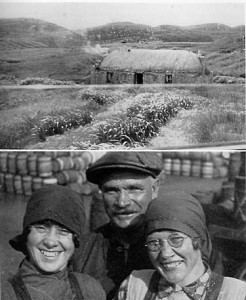
Why were traditional diets so healthy?
Currently, we’re at an incredibly fortunate point in time; we have real life hunters and gatherers still walking our earth, along with some pretty cool scientific records of ‘natural’ humans in action before they were polluted by the pervasive influence of the West.
Why were traditional diets so healthy?
The national geographic have more experience than most exploring the planets precious untouched places and have gained some wonderful insights and footage. Take a look at this page for to see beautiful footage of hunters and gatherers in action across the world.
What’s clear is that the idea of a single diet adopted by all hunters and gatherers is a total myth.
Both throughout evolution and still today, different parts of the world offer different natural foods and people have adapted well to eating them. What seems to be the driving factor behind the onset of ‘diseases of Westernisation’ is the introduction of modern refined and processed foods and sugar, alongside a combination of unhealthy lifestyle factors.
Weston A Price’s work conducted in the 1930s and available to read in his book ‘Nutrition and Physical Degeneration, a comparison of primitive and modern diets and their effects’ illustrates this beautifully.
Weston Price’s work is so important because it offers us a snapshot of the health of humans all over the world in an era when there were still people eating and living in traditional or primitive ways close to people of the same genetic hardwiring who had slipped into more modern ways of being.
Weston Price asserts that people’s overall health can be judged by looking at certain physical features including their teeth.
One example in Weston Price’s study is In Scotland on the remote, windswept and wild Isle of Lewis, the traditional people lived in peat smoke infused cottages, worked their bodies hard and lived on a diet of predominantly seafood, oatmeal with some barley – including the delicacy baked fish head with chopped cods liver and oatmeal.

Price found the traditional Gaelic people healthy, robust and their teeth averaged less than one cavity in a hundred. Nearby where the boats were regularly bringing refined flour, jams, canned food and sugar, the story was quite different. The incidence of cavities in children in these areas were 32.4 in every hundred teeth examined!
When Price requested additional figures from the government he came to learn that the average height of men in some parts of Scotland had reduced by 4 inches in just fifty years.
In another example, Price studied the people of Peru and was delighted to have the opportunity to photograph and analyse the health of a tribe of unmodernised Amazon Jungle Indians who he describes as ‘finest Indians we have seen.’ In this group, he couldn’t find a single dental cavity and witnessed spectacular indicators of health. Their diet included the liberal use of fish, small animals, birds, eggs, plants, fruits and large amounts of yucca which is a starchy root vegetable. Once again it was in stark contrast to the nearby modernised areas of civilisation where white flour, sugar, canned foods and refined produce were commonly eaten. Here the broad faces, high dental arches, and robust stature gave way to ill health and widespread dental caries.

Here are the dietary recommendations formed by analysing Weston A Price’s extensive studies – you can read much more Weston Price Web Site.
Eat whole, unprocessed foods.
Eat beef, lamb, game, organ meats, poultry, and eggs from pasture-fed animals.
Eat wild fish (not farm-raised), fish eggs and shellfish from unpolluted waters.
Eat full-fat milk products from pasture-fed cows, preferably raw and/or fermented, such as raw milk, whole yogurt, kefir, cultured butter, full-fat raw cheeses and fresh and sour cream.
Use animal fats, such as lard, tallow, egg yolks, cream and butter liberally.
Use only traditional vegetable oils—extra virgin olive oil, expeller expressed sesame oil, small amounts of expeller-expressed flax oil, and the tropical oils—coconut oil, palm oil and palm kernel oil.
Take cod liver oil regularly to provide at least 10,000 IU vitamin A and 1,000 IU vitamin D per day.
Eat fresh and vegetables, preferably organic. Use vegetables in salads and soups, or lightly steamed with butter.
Use whole grains, legumes and nuts that have been prepared by soaking, sprouting or sour leavening to neutralize phytic acid, enzyme inhibitors and other anti-nutrients.
Include enzyme-rich lacto-fermented vegetables, fruits, beverages, and condiments in your diet on a regular basis.
Prepare homemade stocks from the bones of chicken, beef, lamb and fish and use liberally in soups, stews, gravies and sauces.
Use filtered water for cooking and drinking.
Use unrefined salt and a variety of herbs and spices for food interest and appetite stimulation.
Make your own salad dressing using raw vinegar, extra virgin olive oil and a small amount of expeller-expressed flax oil.
These recommendations offer a helpful template for a healthy diet, but there could be a further piece to this human diet puzzle; it’s called ‘Gene-culture co-evolution.’
We may all share the same basic human genetic hardwiring, but there is considerable room for adaptation in different cultures through the process of natural selection. Our planet’s habitats and landscapes are diverse, and before globalisation, we mostly ate from within a small geographical range.
In a group of people forced to adopt a particular lifestyle or dietary habit, those who don’t tolerate it well will often become sick or die and are certainly the least likely to have children and therefore pass on their genes. If this continues over a few generations, It’s not hard to imagine how these selection pressures can accelerate particularly during hard times such as famine or necessary migration.
A great example of gene-culture co-evolution is how well some people digest milk. Our genetic hardwiring tells our bodies we no longer need to digest milk after we are weaned from Human milk, most people across the world lose the ability to digest milk successfully as they reach adulthood. Milk contains the sugar lactose, and this molecule requires our bodies to produce lactase to break it down.
Studies show that it’s common among people in Europe and a few other areas of the world to continue producing lactase as adults.
Approximately 9000 years ago certain pastoralist cultures domesticated large animals and harvested their nutrient-rich milk. Certain rare genetic variations or mutations allowed lucky individuals to thrive on this delicious product. Natural selection – over many generations – favored lactose tolerant people, creating societies of people more able to drink milk. (1)
If you took people, who had lived for generations on a diet of wild plants, fermented milk, and starchy tubers and moved them to Alaska and forced them to adopt a local traditional diet high in fish and animal fat you would encounter some serious digestive distress! These people have the same genetic blueprint, and both cultures can be very healthy while eating their own native diet, but selection pressure has taken their digestive capabilities in very different directions.
The same applies to how well we metabolise alcohol. I am pleased to report that I come from a long line of Europeans who throughout Medieval times consumed, beer and wine far more frequently than water!
This wonderful video illustrates the importance of our cultural heritage on dietary choices.
Sadly, however, I also seem to have come from a line of women with “thrifty genes.” According to the Gianfranco’s Hypothesis, the ‘thrifty’ genotype would have allowed hunter-gatherers (especially childbearing Women) to fatten more quickly in times of abundance. People in possession of this gene can rest assured they will fair well in times of famine. In our plentiful Western culture, however, this genotype could be partly responsible for widespread chronic obesity and the increase in diabetes. (2)
Caroline
References; Why were traditional cultures so healthy?
UK link Nutrition and Physical Degeneration: A Comparison of Primitive and Modern Diets and Their Effects
USA link Nutrition and Physical Degeneration: A Comparison of Primitive and Modern Diets and Their Effects
1. http://anthro.palomar.edu/adapt/adapt_5.htm
2. http://www.ncbi.nlm.nih.gov/pmc/articles/PMC1932342/


No Comments